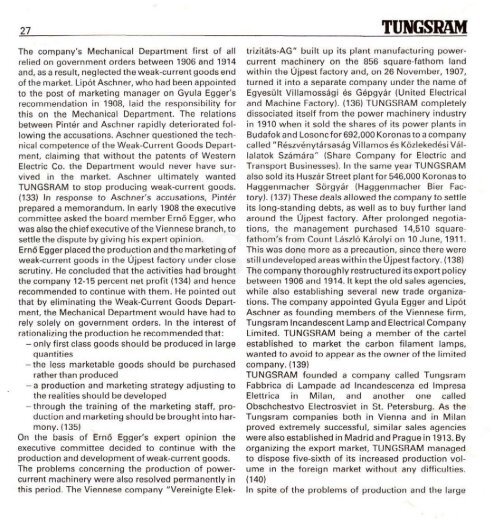THE HISTORY OF TUNGSRAM 1896-1945 - MEK
THE HISTORY OF TUNGSRAM 1896-1945 - MEK
THE HISTORY OF TUNGSRAM 1896-1945 - MEK
- No tags were found...
Create successful ePaper yourself
Turn your PDF publications into a flip-book with our unique Google optimized e-Paper software.
27 TU\GSRANThe company's Mechanical Department first of allrelied on government orders between 1906 and 1914and, as a result, neglected the weak-current goods endof the market. Lipot Aschner, who had been appointedto the post of marketing manager on Gyula Egger'srecommendation in 1908, laid the responsibility forthis on the Mechanical Department. The relationsbetween Pinter and Aschner rapidly deteriorated followingthe accusations. Aschner questioned the technicalcompetence of the Weak-Current Goods Department,claiming that without the patents of WesternElectric Co. the Department would never have survivedin the market. Aschner ultimately wanted<strong>TUNGSRAM</strong> to stop producing weak-current goods.(133) In response to Aschner's accusations, Pinterprepared a memorandum. In early 1908 the executivecommittee asked the board member Erno Egger, whowas also the chief executive of the Viennese branch, tosettle the dispute by giving his expert opinion.Erno Egger placed the production and the marketing ofweak-current goods in the Ojpest factory under closescrutiny. He concluded that the activities had broughtthe company 12-15 percent net profit (134) and hencerecommended to continue with them. He pointed outthat by eliminating the Weak-Current Goods Department,the Mechanical Department would have had torely solely on government orders. In the interest ofrationalizing the production he recommended that:- only first class goods should be produced in largequantities-the less marketable goods should be purchasedrather than produced-a production and marketing strategy adjusting tothe realities should be developed-through the training of the marketing staff, productionand marketing should be brought into harmony.(135)On the basis of Erno Egger's expert opinion theexecutive committee decided to continue with theproduction and development of weak-current goods.The problems concerning the production of powercurrentmachinery were also resolved permanently inthis period. The Viennese company "Vereinigte Elektrizitats-AG"built up its plant manufacturing powercurrentmachinery on the 856 square-fathom landwithin the Ujpest factory and, on 26 November, 1907,turned it into a separate company under the name ofEgyesiJlt Villamossagi es Gepgyar (United Electricaland Machine Factory). (136) <strong>TUNGSRAM</strong> completelydissociated itself from the power machinery industryin 1910 when it sold the shares of its power plants inBudafok and Losoncfor 692,000 Koronas to a companycalled "Reszvenytarsasag Villamos es Kozlekedesi VallalatokSzamara" (Share Company for Electric andTransport Businesses). In the same year <strong>TUNGSRAM</strong>also sold its Huszar Street plant for 546,000 Koronas toHaggenmacher Sorgyar (Haggenmacher Bier Factory).(137) These deals allowed the company to settleits long-standing debts, as well as to buy further landaround the Ujpest factory. After prolonged negotiations,the management purchased 14,510 squarefathom'sfrom Count Laszio Karoiyi on 10 June, 1911.This was done more as a precaution, since there werestill undeveloped areas within the Ujpest factory. (138)The company thoroughly restructured its export policybetween 1906 and 1914. It kept the old sales agencies,while also establishing several new trade organizations.The company appointed Gyula Egger and LipotAschner as founding members of the Viennese firm,Tungsram Incandescent Lamp and Electrical CompanyLimited. <strong>TUNGSRAM</strong> being a member of the cartelestablished to market the carbon filament lamps,wanted to avoid to appear as the owner of the limitedcompany. (139)<strong>TUNGSRAM</strong> founded a company called TungsramFabbrica di Lampade ad Incandescenza ed ImpresaElettrica in Milan, and another one calledObschchestvo Electrosviet in St. Petersburg. As theTungsram companies both in Vienna and in Milanproved extremely successful, similar sales agencieswere also established in Madrid and Prague in 1913. Byorganizing the export market, <strong>TUNGSRAM</strong> managedto dispose five-sixth of its increased production volumein the foreign market without any difficulties.(140)In spite of the problems of production and the large








![Letöltés egy fájlban [4.3 MB - PDF]](https://img.yumpu.com/50159926/1/180x260/letaltacs-egy-fajlban-43-mb-pdf.jpg?quality=85)







